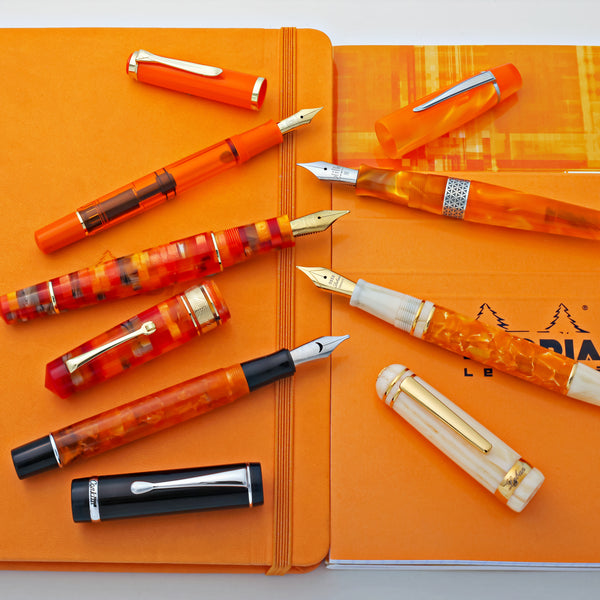Parker Pen History
(Some images courtesy of Vintage Pens)
For over a century, Parker Pens have been recognized for their dependable quality, precision writing, and prestigious style. The company's numerous lines of pens and copious list of innovations earned Parker Pens its reputation. However, the road to triumph took years of determination.
1888: George Safford Parker established the Parker Pen Company in Janesville, Wisconsin after failing to find a pen that wrote well and didn’t leak.
1889: George Safford Parker patented his first fountain pen.
1891: W.F. palmer invested in the Parker Pen Company. His initial investment of $1,000 launched business for the company.

1894: The Lucky Curve feed system, a system that allowed ink to flow back into the reservoir, was introduced, giving the company its first technological break through and making it a big contender in the fountain pen industry.
1898: The slip on outer pen cap was patented.
1899: Parker designed the greatest achievement of the pen age, the first jointless pen.
1900: Gold Filigree Lucky Curve Pens were introduced, as well as a patent on the outer cap’s taper, allowing it to fit more firmly.
1903: Parker sought to establish overseas markets by embarking on a world tour.
1905: The company met consumer needs for large stylish fountain pens by introducing the Black Giant, and, in the same year, the “Spear-Head” ink feed was developed.
1906: Parker released the Emblem Pen, which contained an engraved mark of a secret society.
1907: The Snake Pen, in sterling silver and gold, was launched.
1911: The Lucky Curve feed system was improved and patented.
1912: A new form of the safety cap was introduced.
During World War I, Parker signed a contract with the US War Department for the Trench Pen,
a pen holding black pellets that when added to water transformed into ink. The contract assured
financial success for the company during the war.
1914: George Safford Parker’s son, Russell, joined the company in order to concentrate on production and administration.
1916: The Jack-Knife safety pen made its debut.
1918: The company’s annual sales surpassed $1 million.
1919: George Safford Parker’s son, Kenneth, joined the company, and a new building for corporate headquarters was constructed.
1920’s: The mechanical pencil was invented. Also, Parker worked to establish distributorships in Europe, Australia, India, and the Orient.
1921: The Parker Company launched their most famous pen, the Duofold fountain pen.
The pen gave Parker the reputation of the company with the most dependable pens.
At $7.00, the pen was not only the most fashionable of its time, it was also the most expensive.
1923: The Duofold pencil followed the Duofold pen’s release. Also, a manufacturing subsidiary was opened in Canada.
1924: The Parker Company opened a distribution company in London to handle Canada’s production. The site distributed Parker Pens throughout Europe.
1926-1927: The Duofold pen line extended to include colors in Jade Green, Mandarin Yellow, Lapis Blue, and Pearl and Black. The new pens were available in a new form of durable plastic called Permanite.
 1931: The breakthrough of Quink ink joined the list of innovations for the company.
1931: The breakthrough of Quink ink joined the list of innovations for the company.
1933: Parker Pen engineering created the Vacumatic, consisting of a mechanism that held over twice as much ink as the Duofold. In the same year, artist Joseph Platt designed the Parker arrow clip.

1937: The company lost its founder, George Safford Parker, however, Parker Pens continued to flourish.
1941: A cigar-shaped design and hooded nib defined the Parker 51, earning the company prestigious design awards. Popularity and demand for the pen surpassed production.
1948: The Parker 21, a less expensive version of the Parker 51, was introduced in 1948.
1949: The parker company continued to explore overseas markets by establishing a subsidiary in South Africa, followed by facilities in France and Mexico.
1954: Parker Pens maintained their success with the Parker Jotter, the first quality ballpoint pen with a large cartridge. The pen, with its rotating point to prevent wear, wrote more than five times longer than standard ballpoint pens.

1956: Parker established the Parker 61, a fountain pen designed to “self-draw” ink from the bottle for six hours of continuous writing.
1957: The tungsten carbide textured ball, T-ball, was designed, using a stainless steel sphere that allowed the pen to grip the surface of the paper, preventing blobbed writing. The T-ball became a part of the Jotter, forming the T-Ball Jotter.
1958: Subsidiary opened in Australia.
1959: Subsidiary opened in Argentina.
1960: Subsidiaries opened in Brazil and West Germany. Also, the Parker 45, Parker’s first ink cartridge pen, was introduced.
1962: Parker was awarded the Royal Warrant from the Royal British Household, as their sole supplier of pen and inks. In addition, subsidiaries were opened in Peru and Columbia.
1964: In celebration of their 75th anniversary, Parker released the Parker 75, a special edition fountain pen in sterling silver and with a 14k gold nib.
1966: Parker’s first attempt with roller balls occurred with the Touche.
1967: Parker revealed the Classic line of slim-contour writing instruments.
1968: The Automatic Mechanical Pencil, also known as the Cartridge Pencil, with the ability to print up to 50,000 words, was launched.
1970: The Big Red was released, a lower end pen modeling the Parker Duofold look.
1975: The Systemark characterized the first roller ball pen for Parker. It consisted of a fountain pen ink system and a T-ball.
1976 - 1978: Parker introduced five new lines of pens, Parker 180, Parker 25, Parker 50, Ms. Parker, and Swinger.
1981: The Arrow collection marked the new decade with its fashionable pocket clip.
1982: The Parker Vector roller ball made its appearance, followed by the Vector fountain pen, ball pen, and pencil.

1983: Parker created their premier collection of luxury writing instruments. The handcrafted pens, with their cherished metals, took up to six weeks to produce.
1986: The Writing Instruments Division was bought out by the UK management team, moving corporate headquarters to Newhaven, England. Although the world was in recession, Parker managed to increase turnover by nearly 50%, in the five years following the buyout.
1988: In celebration of its 100th birthday, the Parker Duofold was re-launched as the 
highly successful Duofold Centennial. Also that year, Parker released the Parker 88,
inspired by French fashion yet still depicting the classic Parker style.
1989: Duofold owners were offered elite privileges and complimentary services after Parker established the Platinum Club in the US and Australia.
1990: Parker introduced the Parker International, a slimmer and shorter version of the Duofold Centennial, which was followed by the Duofold roller ball. The ball pen and pencil consisted of a brass tassie design and utilized solid blocks of hand-cast acrylic trimmed in 23K gold plate. It proved impervious to wear due to its diamond polished lustre.

1991: The birth of the precision-engineered Insignia collection was put on the market to suite the needs of the professional user.
1992: Pearl and Black were added to the Duofold collection. In addition, Parker added a new selection of colors and a special black trim to their 88 collection.
 1993: Technologically-advanced Sonnet pens and Penman accessories appeared on the market. That same year, the Gillette Company attained Parker.
1993: Technologically-advanced Sonnet pens and Penman accessories appeared on the market. That same year, the Gillette Company attained Parker.
1994: The 88 line was re-launched as Rialto. It still included all of the popular features of the previous 88, however, its style was refined and functional changes improved performance.
1995: Parker announced a new Vector range with metallic, translucent, and dichroic finishes.
1996: Parker introduced the Frontier line. Duofold’s style was modified and released in the three new finishes of gemstones, replacing the previous marble finishes. Also, Rialto gained three new finishes and Insignia, four.


1999: Parker prepared for a 2000 reinvention with a new logo, new products, new refills, new packaging, and a new image.
2000: The Sanford Company took over Parker pens after their acquisition of the Gillette Company’s stationary products group.
2001: The company continued to expand their products with the introduction of the Inflection line and the expansion of Ellipse range to include the roller ball and the pencil. Also, Parker released the Duofold Mosaic Special Edition as a limited product offer. And, the company launched the stainless steel reflex as well as two new refills: Gel and Needlepoint.


2002: The Parker 51 made its comeback as a special edition pen with a cap in resemblance to the façade of New York City’s Empire State building. Also that year, Parker created a 23K gold-plated Duofold with an engraving of an extract from the Proclamation of Accession.

Today, Parker Pens are used all around the world and sold in over 120 countries. From Truman to Bush, Parker's signature design and streamlined craftsmanship have even made the pens the choice for the nation's leaders, solidifying their status as the best Parker pen 2024.








 1931: The breakthrough of Quink ink joined the list of innovations for the company.
1931: The breakthrough of Quink ink joined the list of innovations for the company. 1993: Technologically-advanced Sonnet pens and Penman accessories appeared on the market. That same year, the Gillette Company attained Parker.
1993: Technologically-advanced Sonnet pens and Penman accessories appeared on the market. That same year, the Gillette Company attained Parker.


